8 introductory core stability exercises for children with cerebral palsy

Help us #MakeItHappen!
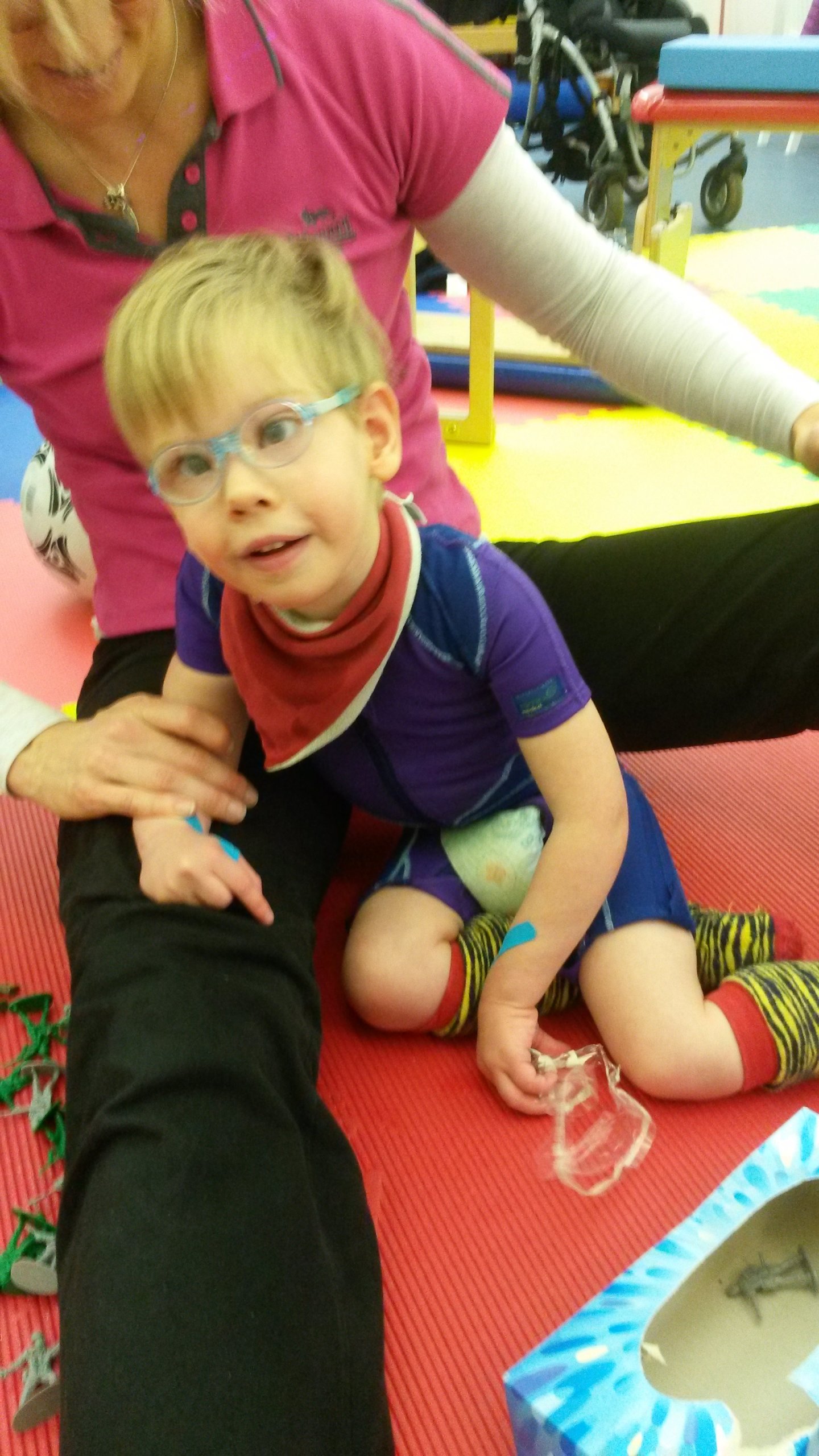
Core stability is key to the workings of our whole body. If we have good core stability, our arms and legs will work better as they are attached to a stable base.
Fine and gross motor (movement) skills are easier to master if we have a strong core.
A stable core allows us to balance in different positions. It enables us to stay still and balanced while our arms and legs work (e.g. walking) or to stay upright when we are on a moving surface (e.g. a bus).
Because our bodies are constantly seeking balance, having a good core increases our ability to focus and concentrate. It is easier to attend to a task if we are able to sit still.
If your child’s muscles are weak, if one muscle is weaker than the other, or if the messages the brain sends to the muscles tells them to work too hard or not hard enough (high tone/low tone), then it is possible that your child will have poor core stability, affecting their other movement skills. This is very common with Cerebral Palsy as it is rare for the core to be completely unaffected.
A child who is mobile on the floor may have some core stability but move in fairly two dimensional ways (forward and back or side to side but not much rotation/twisting). Without rotation, it is not possible to have full core stability as rotation is a core element of full control.
A good core is a great for everyone so working through these activities will be helpful even if your child doesn’t display any particular difficulties.
Core muscle and balance exercises to work through with your child.
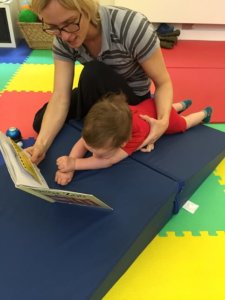
Tummy Time is a brilliant position for strengthening your child’s neck and back. Use a rolled up towel or wedge under their chest to help them to push up on their arms to lift their head (as shown).
As they improve, help them to prop through their elbows while looking up.
Next try to encourage them to be propping through their hands – it may be that a bigger rolled up towel under their chest helps them achieve this.
Once they can do this over a roll, try without the roll.
Read them a book or they can watch TV here so they are motivated to keep looking up and pushing through their hands or elbows.
A progression of this is reaching with 1 hand for a toy or to roll a ball, while leaning on the other arm/ elbow or hand. This will work their core much harder than keeping both arms down. It will also introduce rotation which is key to core stability.
With your child lying on their back, encourage them to touch their toes.
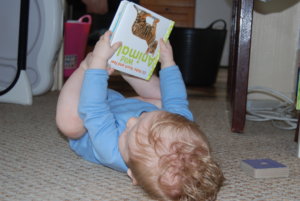
You could put bells or beads on their feet and help them bring their feet up in the air for the child to reach towards their toes.
If they struggle bringing their feet up, place a small rolled up towel under the bottom of their bottom so their feet are already off the floor.
You could also roll up a towel and put it under their head and shoulders to help them see what they are doing and bring their arms off the floor, making it easier to reach to their toes.
Once they can touch their toes, encourage them to reach for the opposite foot with the opposite hand. This brings rotation into the trunk which is so often missing for children with physical difficulties.
This can be in ring sit (with their hips wide and knees a bit bent) side sitting (legs going off to one side and leaning through 1 arm), long sitting (with legs straight out in front) or crossed leg sitting.
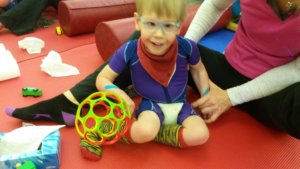
Start by helping them into the position and slowly reduce your support to see if they can stay still. If you need distraction, watching or reading are good as they can stay still for these.
Once they can stay still, start playing with them so that they are using their hands but staying upright.
Move on to reaching outside their base of support – side to side, in front or reaching behind them.
You could also play ‘stuck like glue’ where they have to try and stay upright and you try (gently) to push them over.
Once they can sit still on the floor, try sitting them up over your leg, sat astride a roll or on a bench so their feet are on the floor but their bodies are not supported.
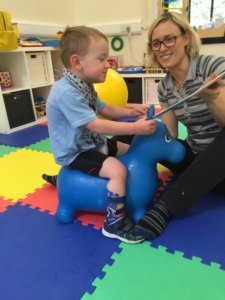
Hold them by their chest to start with and try to move your hands towards their hips as their balance improves. As they adjust to this stay close so you can help them if they fall. They can watch or read something in this position so they don’t have to use their hands. Use this position for a regular activity like evening TV to get lots and lots of practice in.
When they are able to balance when they are still, challenge them by encouraging them to reach out to the side for a toy, reaching to the floor and back up or trying to reach out behind them to challenge their core and their balance.
Once your child has sitting balance on the floor or on the bench/roll, you could try working some sitting balance on a moving object. This could be on a wobble cushion, on a gym ball or, if they fit on your lap, you could move your lap as a moving surface.
Make sure you have complete control of the ball and your child to try this – it may take 2 adults. If you are using the ball, you can wedge it into the corner of the room to make it more stable until you are more confident in our handling.
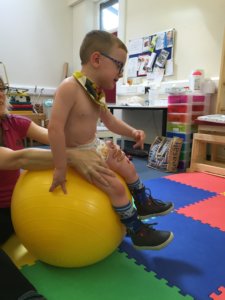
Hold them at their hips so you have control of their bottom on the ball. Very slowly move the ball in all directions.
As they get more confident you can move in bigger movements. Hold the position at the extreme of where they can go to make it a little harder but have a second person ready to catch them if they fall.
This is a fabulous position to work the core. 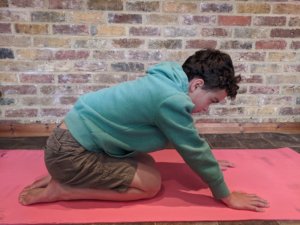
Start by getting your child to try maintaining a hands and knees position. It may be easier to start with your child sitting back on their heels and just balancing through their arms.
As they get stronger, move their bodies forward in slow progressions, just a little bit further each time you try this activity until their shoulders are over their hands and their hips are over their knees.
In these positions the best things to do are to watch something on a TV or tablet/ iPad or to read books.
Rolling is a fabulous activity which can use some lovely rotation muscles. Many children with physical difficulties miss this stage out as rotation can be extra hard for them so it is a good activity to encourage.
To roll to the right from back to front to back.
Lift the right arm straight above your child’s head
Bend the left hip and knee up.
Use a toy to encourage your child to look to the right and reach across the body with the left arm to initiate rolling. Help them bring their left leg over if this is too hard for them to do on their own.
As they roll over onto their tummy, straighten out the left leg so they are flat on their tummy with both arms out in front of them.
To get from tummy to back, bend up the right leg so the knee comes up towards the chest.
Encourage your child to push up with their right hand on the floor so that they roll over onto their back.
Sometimes a more advanced position can help you work a more immature skill. Standing can be great to work the core even if your child is not yet ready to stand developmentally.
Prop your child in standing at furniture. They may use their hands to balance themselves and you can help them stay on their feet by holding onto their legs, using leg gaiters or allowing them to perch their bottom on your knees if you are sat behind them or on another surface. If handling them in standing is too hard then wait to do this exercise until this becomes easier.
Standing still leaning on furniture with their hands is the first step.
Move on to asking them to play with their hands in front. If they are able to reach to the side then even better.
Work towards them letting go of the furniture all together so they are balancing their core while you hold their legs.
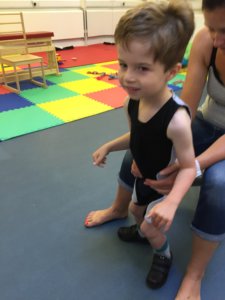
Once they can hold this, try shifting their weight side to side over their legs or back and forward so they have to adjust their core to stay upright.
If they manage this, ask them to reach forward to pick up objects off the floor and then come back up. If this is too hard, use one hand on their tummy to help them come up so they don’t just arch their head and back. This way they will be working all their core muscles in this fantastic exercise.
If you have completed all of these core stability exercises, try these more advanced core stability exercises.





